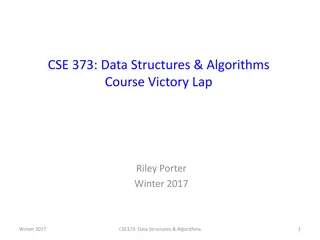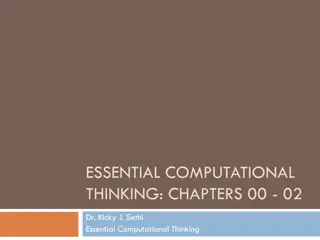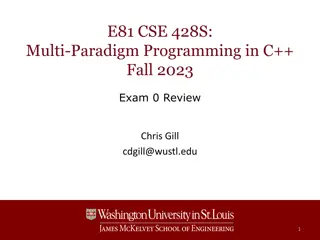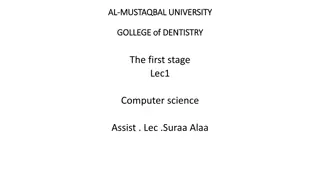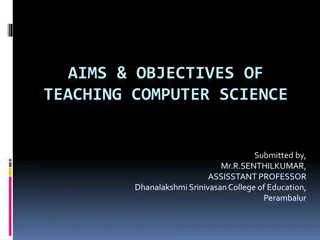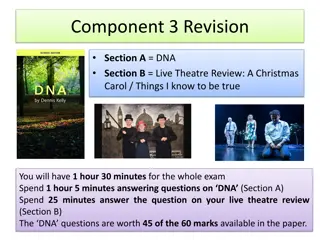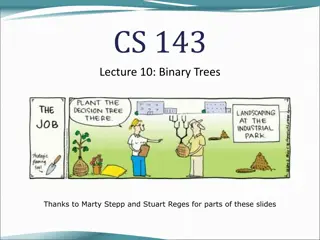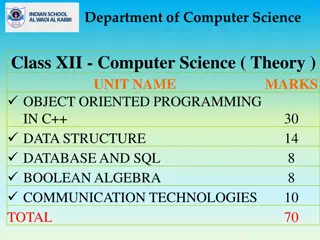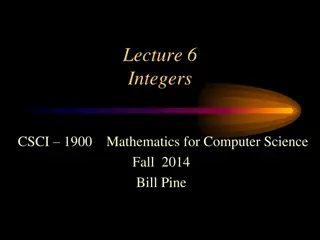Key Concepts in AP Computer Science A Exam Review
Essential topics covered in AP Computer Science A Exam include identifiers, primitive data types, number representation, final variables, and arithmetic operators. Recognizing the basics, such as types, identifiers, operators, and control structures, is crucial for success in the exam. Understanding how numbers are stored, including integer and floating-point representations, along with common operations like addition, subtraction, multiplication, and division, is fundamental. Memorizing Integer.MIN_VALUE and Integer.MAX_VALUE helps in handling integer limits efficiently.
Download Presentation

Please find below an Image/Link to download the presentation.
The content on the website is provided AS IS for your information and personal use only. It may not be sold, licensed, or shared on other websites without obtaining consent from the author. Download presentation by click this link. If you encounter any issues during the download, it is possible that the publisher has removed the file from their server.
E N D
Presentation Transcript
AP Computer Science A Exam Review What you ABSOLUTELY MUST KNOW above everything else (according to the Barron s test prep book)
The Basics Every AP exam question uses at least one of these: Types and Identifiers Operators Control structures
Identifiers Identifiers name for variable, parameter, constant, user-defined method/class, etc. Convention says identifiers for variables and methods will be lowercase (with uppercase letters to separate multiple words) E.g. getName, findSurfaceArea, preTaxTotal Class names will be capitalized E.g. Student, Car, BankAccount
Built-in/Primitive Types int an integer, e.g. 5, -77, 9001 boolean a boolean, true or false double a double precision floating-point number, 2.718, -3456.78, 1.4e5
Storage of numbers int types use 32 bits, largest integer is 231- 1 Floating-point numbers use mantissa and exponent: sign*mantissa*2???????? When floating point numbers are converted to binary, most cannot be represented exactly, leading to round-off error
Miscellaneous Note #1 Integer.MIN_VALUE and Integer.MAX_VALUE Represent the absolute lowest and highest values that can be stored in an integer If you re trying to find the minimum or maximum value of an array or ArrayList, initialize your variable to these
Number representation Decimal base 10 regular numbers Binary base 2 zeros and ones Hexadecimal base 16 0-F Octal base 8 0-7 ?.?.25??? 11001??? 19 ?? 31???
Final Variables final variable is a quantity whose value will not change E.g. final int CLASS_SIZE = 30
Arithmetic Operators Operator + - * / Meaning Addition Subtraction Multiplication Division Example 3 + x p q 6 * i 10 / 4 //returns 2 11 % 8 //returns 3 % Mod (remainder)
Arithmetic Operators Notes Integer division truncates the answer (cuts off the decimal) Use type casting to control how to divide. Which do not evaluate to 0.75? 3.0 / 4 3 / 4.0 (int) 3.0 / 4 (double) 3 / 4 (double) (3 / 4)
Relational Operators Operator Meaning Example == Equal to if (x == 100) != Not equal to if (age != 21) > < Greater than Less than if (salary > 30000) if (grade < 65) >= Greater than or equal to if (age >= 16) <= Less than or equal to if (height <= 6)
Relational Operators Notes Should only be used for primitive types (i.e. int, double, boolean) Be careful for comparing floating-point numbers due to round-off error
Logical Operators Operator Meaning Example ! NOT if (!found) && AND if (x < 3 && y > 4) || OR if (age < 2 || height < 4)
Logical Operators Example (x && y) || !(x && y) A. Always true B. Always false C. true only when x is true and y is true D. true only when x and y have the same value E. true only when x and y have different values
Another example Which is equivalent to: !(a < b) && !(a > b) A. true B. false C. a == b D. a != b E. !(a < b) && (a > b)
Assignment Operators Operator Example Meaning = x = 2 Simple assignment += x += 4 x = x + 4 -= y -= 6 y = y 6 *= p *= 5 p = p * 5 /= n /= 10 n = n / 10 %= n %= 10 n = n % 10 ++ k++ k = k + 1 -- i-- i = i - 1
Operator Precedence (1) !, ++ (2) *, /, % (3) +, - (4) <, >, <=, >= (5) ==, != (6) && (7) || (8) =, +=, -=, *=, /=, %=
Control Structures if if else if else if while loop for loop for-each loop
if Statement if (boolean expression) { statements } //statements will be executed if boolean expression is true
if example 3 bonus questions must get all correct for 5 points added to grade bonus1, bonus2, and bonus3 are boolean variables that indicate whether they are correct Write an if statement for this example if(bonus1 && bonus2 && bonus3) grade += 5;
ifelse Statement if (boolean expression) { statements //will be executed if boolean expression is true } else { statements //will be executed if boolean expression is false }
ifelse if if (grade.equals( A )) System.out.println( Excellent ); else if(grade.equals( B )) System.out.println( Good ); else if(grade.equals( C )) System.out.println( Poor ); else System.out.println( Invalid );
Other if Notes if/if else if statements do not always need an else at the end An if statement inside of an if statement is a nested if statement: if (boolean expr1) if (boolean expr2) statement; Can also be written as: if (boolean expr1 && boolean expr2) statement;
Rewrite using only ifelse if(value < 0) return Not in range ; else if(value > 100) return Not in range ; else return In range ; if(value < 0 || value > 100) return Not in range ; else return In range ;
While vs. For loops While loops For loops int i = 0; while (i < 100) { //repeated code i++; } for(int i = 0; i<100; i++) { //repeated code }
While vs. For-each loops While loop For-each loop int[] locationCells int[] locationCells = new int[100]; = new int[100]; int i = 0; while (i < 100) { System.out.println (locationCells[i]); i++; } for(int cell : locationCells) { System.out.println(cell); }
For loop vs. for-each loop For loop For-each loop for(int i = 0; i<100; i++) { System.out.println (locationCells[i]); } for(int cell : locationCells) { System.out.println(cell); }
For loop vs. for-each loop For loop For-each loop Easier to write when simply accessing data from an array Not much better than a while loop if not accessing array data Has an index useful for setting data that depends on the index Initialization, boolean test, and iteration expression are all in one line
While loop example int value = 15; while (value < 28) { System.out.println(value); value++; } What is the first number printed? 15 What is the last number printed? 27
Another example int a = 24; int b = 30; while (b != 0) { int r = a % b; a = b; b = r; } System.out.println(a); A. 0 B. 6 C. 12 D. 24 E. 30
Yet another example int k = 0; while (k < 10) { System.out.print ((k % 3) + ); if ((k % 3) == 0) k = k + 2; else k++; } A. 0 2 1 0 2 B. 0 2 0 2 0 2 C. 0 2 1 0 2 1 0 D. 0 2 0 2 0 2 0 E. 0 1 2 1 2 1 2
For loop example String str = abcdef ; for (int r = 0; r < str.length()-1; r++) System.out.print(str.substring(r, r+2)); What is printed? A. abcdef B. aabbccddeeff C. abbccddeef D. abcbcdcdedef E. Nothing, IndexOutOfBoundsException thrown
Another example public void numberCheck(int maxNum) { int typeA = 0; int typeB = 0; int typeC = 0; for (int k = 1; k<=maxNum; k++) { if (k%2 == 0 && k%5==0) typeA++; if (k%2 == 0) typeB++; if (k%5 == 0) typeC++; } System.out.println(typeA + + typeB What is printed by numberCheck(50)? A. 5 20 5 B. 5 20 10 C. 5 25 5 D. 5 25 10 E. 30 25 10 + + typeC); }
Yet another example for (int outer = 0; outer < n; outer++) for(int inner = 0; inner <= outer; inner++) System.out.print(outer + ); If n has a value of 4, what is printed? A. 0 1 2 3 B. 0 0 1 0 1 2 C. 0 1 2 2 3 3 3 D. 0 1 1 2 2 2 3 3 3 3 E. 0 0 1 0 1 2 0 1 2 3
Objects, Classes, and Inheritance You may have to write your own class. You ll definitely need to interpret at least one class that s given. Very common, esp. on FRQ. Methods Subclasses Abstract classes Interfaces
Method Headers With the exception of constructors, all method headers should have these 4 things: Access modifier: public, private Return type: void, int, double, boolean, SomeType, int[], double[], Pokemon[], etc. Method name: e.g. withdraw Parameter list: e.g. String pass, double amt (Some methods may also be static) public void withdraw(String pass, double amt)
Types of Methods Constructors create an object of the class public BankAccount() Accessor gets data but doesn t change data public double getBalance() Mutator changes instance variable(s) public void deposit(String pswd, double amt) Static methods class methods, deals with class variables public static int getEmployeeCount()
Static methods in Driver class Methods in the driver class (the class that contains your main() method) are usually all static because there are not instances of that class. public static void main(String[] args)
Method Overloading Two or more methods with the same name but different parameter lists public int product(int n) {return n*n;} public double product(double x) {return x*x;} public double product(int x, int y){return x*y;} (return type is irrelevant for determining overloading)
Inheritance Inheritance is where a subclass is created from an existing superclass. The subclass copies or inherits variables and methods from the superclass Subclasses usually contain more than their superclass Subclasses can be superclasses for other subclasses
Class hierarchy - Which is true? A. Superclass should contain the data and functionality that are common to all subclasses that inherit from the superclass B. Superclass should be the largest, most complex class from which all other subclasses are derived C. Superclass should contain the data and functionality that are only required for the most complex class D. Superclass should have public data in order to provide access for the entire class hierarchy E. Superclass should contain the most specific details of the class hierarchy
Implementing Subclasses Subclasses copy everything except what? public class Superclass { //superclass variables and methods } public class Subclass extends Superclass { //copies everything from Superclass //EXCEPT constructors }
Inheriting Instance Methods/Variables Subclasses cannot directly access private variables if they are inherited from a superclass Subclasses must use the public accessor and mutator methods (Subclasses can directly access if variables are protected but protected is not in the AP Java subset.)
Method Overriding and super If a method has the same name and parameter list in both the superclass and subclass, the subclass method overrides the superclass method To invoke the method from the superclass, use the keyword super E.g. if the superclass has a computeGrade() method, use super.computeGrade() If you are invoking the constructor use super() or super(parameters)
Rules for Subclasses Can add new private instance variables Can add new public, private, or static methods Can override inherited methods May not redefine a public method as private May not override static methods of superclass Should define its own constructors Cannot directly access the private members of its superclass, must use accessors or mutators
Declaring Subclass Objects Superclass variables can reference both superclass objects and subclass objects Which of these is not valid: Student c = new Student(); Student g = new GradStudent(); Student u = new UnderGrad(); UnderGrad x = new Student(); UnderGrad y = new UnderGrad();
Polymorphism Method overridden in at least one subclass is polymorphic What are method calls are determined by? the type of the actual object the type of object reference Selection of correct method occurs during the run of the program (dynamic binding)
Type Compatibility Only polymorphic if method is overridden E.g. if GradStudent has a getID method but Student does not, this will lead to a compile- time error: Student c = new GradStudent(); int x = c.getID(); //compile-error You can cast it as a subclass object to fix the error: int x = ((GradStudent) c).getID();
Abstract Class Superclass that represents an abstract concept Should never be instantiated May contain abstract methods When no good default code for superclass Every subclass will override abstract methods If class contains abstract methods, it must be declared an abstract class
Notes about abstract classes Can have both abstract and non-abstract methods Abstract classes/methods are declared with keyword abstract Possible to have abstract class without abstract methods Abstract classes may or may not have constructors Cannot create abstract object instances Polymorphism still works


